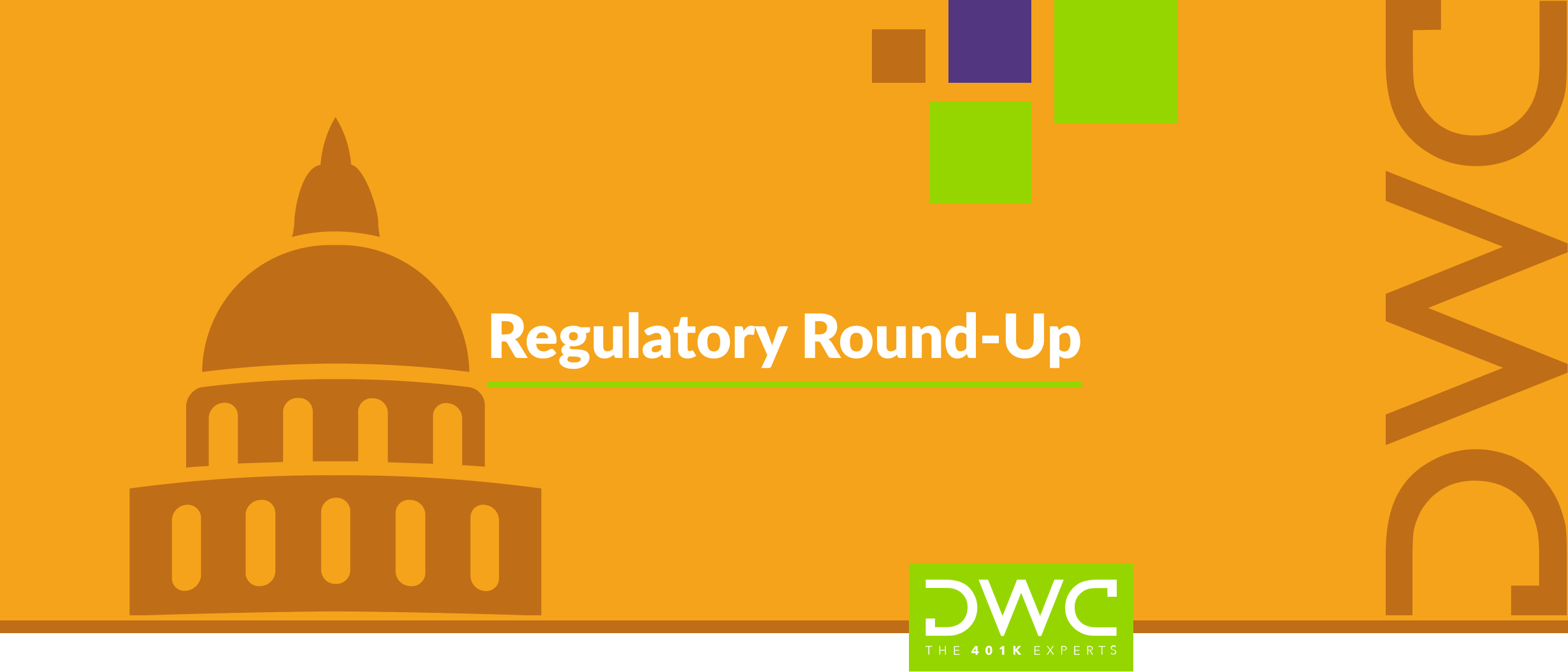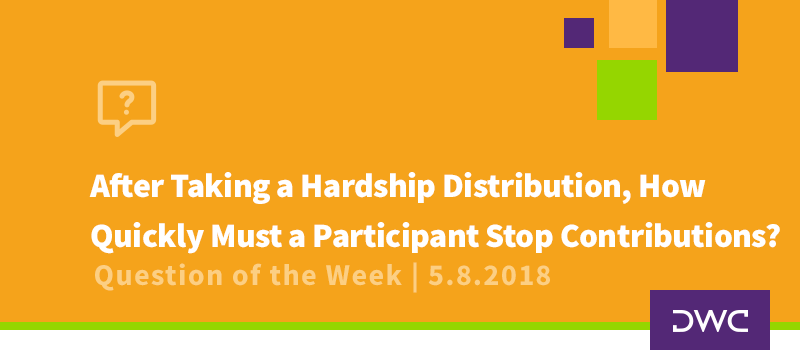
DWC News Update | The CARES Act: Federal Coronavirus Relief
On Friday afternoon, March 27th, Congress passed, and the President signed, the Coronavirus Aid, Relief, and Economic Security (CARES) Act - sweeping legislation intended to provide much-needed relief due to the coronavirus public health emergency. At nearly 1,000 pages in total, the legislation covers a lot of ground in a many areas. With respect to company-sponsored retirement plans, the relief focuses on four areas:
- Creates a new type of distribution – the coronavirus-related distribution – to give access to those still employed as well as those out of work while minimizing some of the negative tax consequences
- Expands the availability of plans loans and allows for temporary suspension of payments
- Waives required minimum distributions for 2020
- Provides funding relief for certain defined benefit plans
This post provides a rundown of the provisions. We have also updated our FAQ and will be providing additional information via our Questions of the Week over the coming days and weeks.
Coronavirus-Related Distributions
Participants who meet the criteria described below can treat distributions from the plan (or an IRA) of up to $100,000 during calendar year 2020 as coronavirus-related distributions. This is effective retroactively to January 1, 2020, and includes any distributions taken from then through the end of this year. Even better, the new law provides for three forms of special tax treatment:
- The 10% early withdrawal penalty is waived.
- The normal requirement to withhold 20% in federal taxes at the time of distribution is waived.
- Though the distribution must be included in taxable income, it can be spread in equal installments over a period of up to three tax years.
Example
Cooper, age 40, is a participant in his company’s 401(k) plan. He takes a distribution this year from the plan in the amount of $75,000. Under the normal rules, $15,000 (20%) would be withheld in federal income taxes, leaving Cooper with only $60,000 cash in hand. There would be a penalty of $7,500 (10%) for withdrawing the amount prior to age 59 ½, and Cooper would have to treat the entire $75,000 as taxable income for this year.
Under the CARES relief, Cooper would receive the full $75,000 in cash with no withholding. The $7,500 penalty is waived, and he can include $25,000 in taxable income per year for 2020-2022, which not only reduces the immediate tax burden but could also avoid bumping him into a higher tax bracket.
Option to Repay
To take it one step further, participants are able to repay their coronavirus-related distributions over time. The repayment window is three years from the date a participant actually receives the distributed amount. The repayment can be in a single lump sum or in a series of payments throughout the three-year window. And, it is not an all-or-nothing proposition, which means our friend Cooper could repay something less than the entire $75,000, depending on what makes sense for his financial situation.
Repayments are treated as rollovers into the plan, so there is no need to ensure that repayments go back to the source from which they originated. In other words, it is not necessary to break out repayments between deferrals, match, etc.
As noted above, any distribution (including those for termination of employment) taken during calendar year 2020 can be treated as a coronavirus-related distribution, including distributions taken prior to enactment of CARES.
Responsibilities for Tracking
The good news for plan sponsors is that very little of this requires tracking on the part of the plan. As long as the company does not allow a participant to receive more than $100,000 in coronavirus-related distributions from its plan (or from another plan of a related company), there is no requirement that the sponsor double-check to make sure a participant hasn’t already taken coronavirus-related distributions from any other plans or IRAs.
The same goes for any repayments. Since the repayment does not have to be made to the same plan or IRA from which the distribution was paid, it is the participant’s (not the sponsor’s) obligation to ensure that repayments do not exceed the total distribution amount. With that said, since the maximum coronavirus-related distribution is $100,000 per taxpayer, it would be a good idea to seek additional supporting documentation (such as a 2020 Form 1099-R) from any participant seeking to make indirect rollover contributions to your plan that exceeds that amount.
Increased Loan Limits & Payment Postponement
CARES also expands loan availability and provides a reprieve for payments. The relief here is pretty straightforward:
- Availability: Instead of being capped at the lesser of $50,000 or 50% of the vested account balance, a participant can now take a loan for up to the lesser of $100,000 or 100% of his or her vested balance.
- Payment Relief: For new or existing loans, any payments that are otherwise due between March 27, 2020 and December 31, 2020, can be postponed by up to a year. Interest does continue to accrue, but the postponement can extend the otherwise applicable 5-year cap on repayment.
Eligibility for Relief
Any plan sponsor can elect to make coronavirus-related distributions and expanded loan limits available in their plans. Of course, these features must be offered to participant on a nondiscriminatory basis. From a participant standpoint, eligibility for this relief is available on a very broad basis to any participant:
- Who is diagnosed with the virus,
- Whose spouse or dependent is diagnosed,
- Who experiences financial adversity due to being quarantined, laid off, furloughed or having work hours reduced due to the virus; or,
- Who is unable to work due to loss of childcare related to the virus.
Companies are specifically permitted to rely on employees’ representations as to fitting into one of these categories and being eligible for the relief. That means there is no requirement to get a doctor’s note or any other type of more detailed documentation. There is no mention as to whether the employee’s certification must be in writing or if verbal is acceptable. The more conservative approach would be to request something in writing, even if just an email, attesting to eligibility. It is also possible that the recordkeepers that actually process the payments may include some sort of formal attestation on their distribution forms or participant websites.
RMD Waiver
While the above relief focuses on giving participants greater access to their accounts in a time of need, CARES also makes it possible for certain individuals to forego taking distributions that would otherwise be required. We are referring here to required minimum distributions that are typically mandatory each year for certain participants who reach age 70 ½ (or age 72, starting this year, thanks to the SECURE Act).
RMDs are based on a participant’s account balance as of the last day of the previous year (December 31, 2019 for 2020 RMDs). With significant drops in the market over the last few weeks, any RMD calculated based on the end-of-the-year balance would comprise a much larger percentage of the participant’s current balance. To minimize the impact, any RMDs from defined contribution plans that are otherwise required during calendar year 2020 are waived. This includes a participant’s initial RMD that is due by April 1, 2020. If a participant has already taken an RMD for 2020, he or she is eligible (though not required) to rollover that amount to an IRA or back into the plan to defer the taxes even though RMDs are not usually eligible to be rolled over. This relief is across the board for all DC participants and does not require them to fit into one of the above criteria to be eligible.
Implementation & Plan Amendments
The above provisions are optional, meaning that companies are not required to implement them, though we anticipate that most will. For those that do choose to offer some or all of these options, plan amendments are required by the end of the 2022 plan year. We were already working on an operational checklist for companies to keep track of which of the SECURE Act’s optional provisions they implement, so we will add the CARES Act provisions to the checklist and make it available soon.
Fortunately, since there are so few tracking requirements imposed on the plan with respect to this relief, there are not really any practical impediments to making these provisions available right away. Given that in-service distributions are normally age-restricted, recordkeepers may need to make some adjustments to their processes to accommodate the broad-based availability of coronavirus-related distributions based on participants’ self-certifications that they are eligible. Similarly, there may be some modifications necessary with regard to the tax withholding changes.
Funding Relief for Defined Benefit Plans
Unlike 401(k) and profit sharing plans, defined benefit plans (including cash balance plans) specify the total benefit to be provided at retirement. That requires DB plans to remain funded at certain levels to ensure asset levels are sufficient to pay those promised benefits. When the financial markets decline significantly, that often results in funding shortfalls for DB plans, requiring companies to increase contributions at exactly the time when many are least able to afford it.
The CARES Act provides funding relief for single-employer defined benefit plans in two ways:
- The due date for depositing any contributions that would otherwise be due during calendar year 2020 is extended to January 1, 2021; and,
- Companies can use their plan’s funded percentage (referred to as the adjusted funding target attainment percentage or AFTAP) for the immediately preceding plan year (prior to the current market volatility) to determine the plan’s funded status for the 2020 plan year.
Other Relief
While there have not yet been any extensions of certain filing deadlines, such as the Form 5500, CARES does specifically grant the Department Labor the authority to postpone those types of deadlines. We will be watching the situation closely and will be sure to provide updates if/when any such extensions are granted.
In the meantime, the DWC team is here to answer any questions you might have not only about the CARES Act but also how the current environment may impact your plan. If you are not sure who, at DWC, to contact, please reach out to one of the following:
- Doug Hoefer at 651.204.2600, ext. 101 or doug.hoefer@dwc401k.com
- Lori Reay at 651.204.2600, ext. 126 or lori.reay@dwc401k.com


















